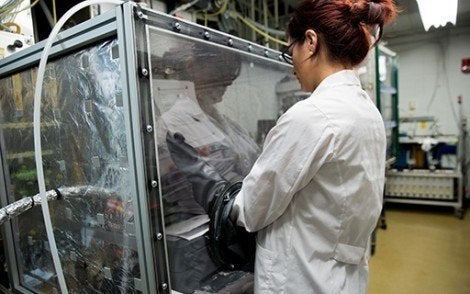Researchers recommend that laser printers be kept in well-ventilated areas
August 11, 2015 — Manufacturers of toner used in consumer laser printers and other printing equipment are incorporating engineered “nano” materials into their formulations to improve quality. It’s a trend seen in a wide range of products from cosmetics to building materials, but the new technology is raising safety concerns. These tiny particles — less than 100 nanometers (billionths of a meter) — are able to reach deep into the lungs when inhaled, potentially causing respiratory and cardiovascular damage.
Researchers at Harvard T.H. Chan School of Public Health’s Center for Nanotechnology and Nanotoxicology recently assessed 11 common laser printers to see if they emitted nanoparticles during use, and if these particles are harmful. The Center examines the potential risks and benefits of nanoparticles used by a variety of industries, hoping to develop a greater understanding of how they interact with the body and the environment — and to provide evidence that will encourage the burgeoning nanotechnology industry to develop in a responsible manner.
“With so many products going nano, safety assessments are needed to safeguard public health,” said Center Director Philip Demokritou, associate professor of aerosol physics. “There is a lack of data on the potential release of these nanomaterials into the air during consumer use, and their possible environmental health hazards.”
For the printer study, the researchers developed an exposure generation system to monitor and assess emissions during use. As toners don’t list the presence of nanoparticles on the product labels, the first step was to confirm that they were indeed present in formulations currently on the market. When tests proved positive, the researchers hit “print” and measured what came out. The results were surprising. They discovered that some printers release particles at concentrations comparable to highly polluted highways.
Further experiments in Demokritou’s lab found that exposure to the particles elicited an array of unfavorable biological responses at the cellular level, including those linked to the development of respiratory and cardiovascular diseases.
But that doesn’t mean that people should stop printing — just that minimizing exposure to nanoparticle emissions during printing might be a good idea. Demokritou and colleagues recommend that laser printers be placed in well-ventilated areas, and that users leave the room during large print jobs.
The study was funded by the National Institute for Occupational Safety and Health and the U. S. Consumer Protection Safety Commission. The most recent of five papers published on the study’s findings appeared online in Environmental Health Perspectives.
The researchers stress that the aim of this work is not to create fear about use of nanotechnologies — which hold potential benefits for health — but to educate consumers and encourage the nanotechnology industry to assess risks early in the development process.
“This study could start the conversation with regulators on establishing safety guidelines for nano-enabled products,” said Sandra V. Pirela, post-doctoral research fellow in the Department of Environmental Health and first author of the EHP paper. “It may also encourage laser printer manufacturers to integrate hardware corrective measures to eliminate the release of nanoparticles during printing.”
Demokritou said, “Our society cannot continue developing and introducing new materials and chemicals into the market without thinking about the mess we may need to clean up 30 years down the road.”
Read more
Printer Emitted Particles: Are they safe? (Center for Nanotechnology and Nanotoxicology)
